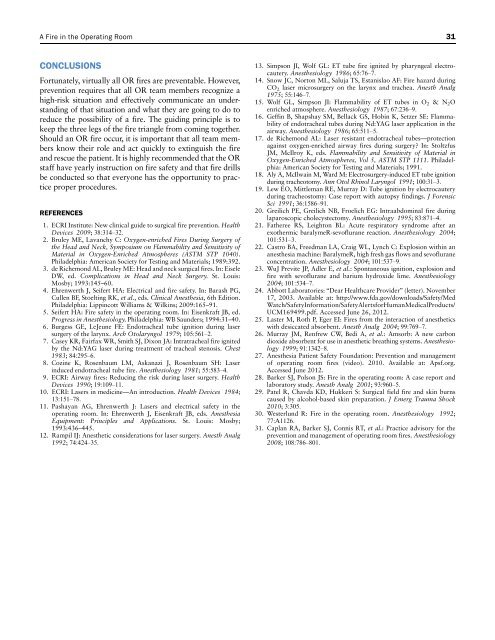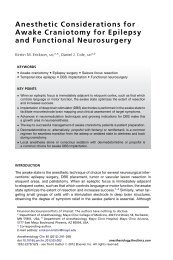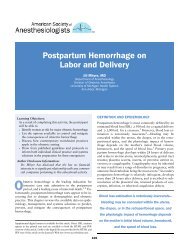A Fire in the Operating Room: It Could Happen to You! - Vtr
A Fire in the Operating Room: It Could Happen to You! - Vtr
A Fire in the Operating Room: It Could Happen to You! - Vtr
You also want an ePaper? Increase the reach of your titles
YUMPU automatically turns print PDFs into web optimized ePapers that Google loves.
A<strong>Fire</strong><strong>in</strong><strong>the</strong>Operat<strong>in</strong>g<strong>Room</strong><br />
CONCLUSIONS<br />
Fortunately, virtually all OR fires are preventable. However,<br />
prevention requires that all OR team members recognize a<br />
high-risk situation and effectively communicate an understand<strong>in</strong>g<br />
of that situation and what <strong>the</strong>y are go<strong>in</strong>g <strong>to</strong> do <strong>to</strong><br />
reduce <strong>the</strong> possibility of a fire. The guid<strong>in</strong>g pr<strong>in</strong>ciple is <strong>to</strong><br />
keep <strong>the</strong> three legs of <strong>the</strong> fire triangle from com<strong>in</strong>g <strong>to</strong>ge<strong>the</strong>r.<br />
Should an OR fire occur, it is important that all team members<br />
know <strong>the</strong>ir role and act quickly <strong>to</strong> ext<strong>in</strong>guish <strong>the</strong> fire<br />
and rescue <strong>the</strong> patient. <strong>It</strong> is highly recommended that <strong>the</strong> OR<br />
staff have yearly <strong>in</strong>struction on fire safety and that fire drills<br />
be conducted so that everyone has <strong>the</strong> opportunity <strong>to</strong> practice<br />
proper procedures.<br />
REFERENCES<br />
1. ECRI Institute: New cl<strong>in</strong>ical guide <strong>to</strong> surgical fire prevention. Health<br />
Devices 2009; 38:314–32.<br />
2. Bruley ME, Lavanchy C: Oxygen-enriched <strong>Fire</strong>s Dur<strong>in</strong>g Surgery of<br />
<strong>the</strong> Head and Neck, Symposium on Flammability and Sensitivity of<br />
Material <strong>in</strong> Oxygen-Enriched Atmospheres (ASTM STP 1040).<br />
Philadelphia: American Society for Test<strong>in</strong>g and Materials; 1989:392.<br />
3. de Richemond AL, Bruley ME: Head and neck surgical fires. In: Eisele<br />
DW, ed. Complications <strong>in</strong> Head and Neck Surgery. St. Louis:<br />
Mosby; 1993:145–60.<br />
4. Ehrenwerth J, Seifert HA: Electrical and fire safety. In: Barash PG,<br />
Cullen BF, S<strong>to</strong>elt<strong>in</strong>g RK, et al., eds. Cl<strong>in</strong>ical Anes<strong>the</strong>sia, 6th Edition.<br />
Philadelphia: Lipp<strong>in</strong>cott Williams & Wilk<strong>in</strong>s; 2009:165–91.<br />
5. Seifert HA: <strong>Fire</strong> safety <strong>in</strong> <strong>the</strong> operat<strong>in</strong>g room. In: Eisenkraft JB, ed.<br />
Progress <strong>in</strong> Anes<strong>the</strong>siology. Philadelphia: WB Saunders; 1994:31–40.<br />
6. Burgess GE, LeJeune FE: Endotracheal tube ignition dur<strong>in</strong>g laser<br />
surgery of <strong>the</strong> larynx. Arch O<strong>to</strong>laryngol 1979; 105:561–2.<br />
7. Casey KR, Fairfax WR, Smith SJ, Dixon JA: Intratracheal fire ignited<br />
by <strong>the</strong> Nd:YAG laser dur<strong>in</strong>g treatment of tracheal stenosis. Chest<br />
1983; 84:295–6.<br />
8. Coz<strong>in</strong>e K, Rosenbaum LM, Askanazi J, Rosenbaum SH: Laser<br />
<strong>in</strong>duced endotracheal tube fire. Anes<strong>the</strong>siology 1981; 55:583–4.<br />
9. ECRI: Airway fires: Reduc<strong>in</strong>g <strong>the</strong> risk dur<strong>in</strong>g laser surgery. Health<br />
Devices 1990; 19:109–11.<br />
10. ECRI: Lasers <strong>in</strong> medic<strong>in</strong>e—An <strong>in</strong>troduction. Health Devices 1984;<br />
13:151–78.<br />
11. Pashayan AG, Ehrenwerth J: Lasers and electrical safety <strong>in</strong> <strong>the</strong><br />
operat<strong>in</strong>g room. In: Ehrenwerth J, Eisenkraft JB, eds. Anes<strong>the</strong>sia<br />
Equipment: Pr<strong>in</strong>ciples and Applications. St. Louis: Mosby;<br />
1993:436–445.<br />
12. Rampil IJ: Anes<strong>the</strong>tic considerations for laser surgery. Anesth Analg<br />
1992; 74:424–35.<br />
13. Simpson JI, Wolf GL: ET tube fire ignited by pharyngeal electrocautery.<br />
Anes<strong>the</strong>siology 1986; 65:76–7.<br />
14. Snow JC, Nor<strong>to</strong>n ML, Saluja TS, Estanislao AF: <strong>Fire</strong> hazard dur<strong>in</strong>g<br />
CO 2 laser microsurgery on <strong>the</strong> larynx and trachea. Anesth Analg<br />
1975; 55:146–7.<br />
15. Wolf GL, Simpson JI: Flammability of ET tubes <strong>in</strong> O2 & N2O<br />
enriched atmosphere. Anes<strong>the</strong>siology 1987; 67:236–9.<br />
16. Geff<strong>in</strong> B, Shapshay SM, Bellack GS, Hob<strong>in</strong> K, Setzer SE: Flammability<br />
of endotracheal tubes dur<strong>in</strong>g Nd:YAG laser application <strong>in</strong> <strong>the</strong><br />
airway. Anes<strong>the</strong>siology 1986; 65:511–5.<br />
17. de Richemond AL: Laser resistant endotracheal tubes—protection<br />
aga<strong>in</strong>st oxygen-enriched airway fires dur<strong>in</strong>g surgery? In: S<strong>to</strong>ltzfus<br />
JM, McIlroy K, eds. Flammability and Sensitivity of Material <strong>in</strong><br />
Oxygen-Enriched Atmospheres, Vol 5, ASTM STP 1111. Philadelphia:<br />
American Society for Test<strong>in</strong>g and Materials; 1991.<br />
18. Aly A, McIlwa<strong>in</strong> M, Ward M: Electrosurgery-<strong>in</strong>duced ET tube ignition<br />
dur<strong>in</strong>g tracheo<strong>to</strong>my. Ann O<strong>to</strong>l Rh<strong>in</strong>ol Laryngol 1991; 100:31–3.<br />
19. Lew EO, Mittleman RE, Murray D: Tube ignition by electrocautery<br />
dur<strong>in</strong>g tracheos<strong>to</strong>my: Case report with au<strong>to</strong>psy f<strong>in</strong>d<strong>in</strong>gs. J Forensic<br />
Sci 1991; 36:1586–91.<br />
20. Greilich PE, Greilich NB, Froelich EG: Intraabdom<strong>in</strong>al fire dur<strong>in</strong>g<br />
laparoscopic cholecystec<strong>to</strong>my. Anes<strong>the</strong>siology 1995; 83:871–4.<br />
21. Fa<strong>the</strong>ree RS, Leigh<strong>to</strong>n BL: Acute respira<strong>to</strong>ry syndrome after an<br />
exo<strong>the</strong>rmic baralymeR-sevoflurane reaction. Anes<strong>the</strong>siology 2004;<br />
101:531–3.<br />
22. Castro BA, Freedman LA, Craig WL, Lynch C: Explosion with<strong>in</strong> an<br />
anes<strong>the</strong>sia mach<strong>in</strong>e: BaralymeR, high fresh gas flows and sevoflurane<br />
concentration. Anes<strong>the</strong>siology 2004; 101:537–9.<br />
23. WuJ Previte JP, Adler E, et al.: Spontaneous ignition, explosion and<br />
fire with sevoflurane and barium hydroxide lime. Anes<strong>the</strong>siology<br />
2004; 101:534–7.<br />
24. Abbott Labora<strong>to</strong>ries: ‘‘Dear Healthcare Provider’’ (letter). November<br />
17, 2003. Available at: http://www.fda.gov/downloads/Safety/Med<br />
Watch/SafetyInformation/SafetyAlertsforHumanMedicalProducts/<br />
UCM169499.pdf. Accessed June 26, 2012.<br />
25. Laster M, Roth P, Eger EI: <strong>Fire</strong>s from <strong>the</strong> <strong>in</strong>teraction of anes<strong>the</strong>tics<br />
with desiccated absorbent. Anesth Analg 2004; 99:769–7.<br />
26. Murray JM, Renfrew CW, Bedi A, et al.: Amsorb: A new carbon<br />
dioxide absorbent for use <strong>in</strong> anes<strong>the</strong>tic breath<strong>in</strong>g systems. Anes<strong>the</strong>siology<br />
1999; 91:1342–8.<br />
27. Anes<strong>the</strong>sia Patient Safety Foundation: Prevention and management<br />
of operat<strong>in</strong>g room fires (video). 2010. Available at: Apsf.org.<br />
Accessed June 2012.<br />
28. Barker SJ, Polson JS: <strong>Fire</strong> <strong>in</strong> <strong>the</strong> operat<strong>in</strong>g room: A case report and<br />
labora<strong>to</strong>ry study. Anesth Analg 2001; 93:960–5.<br />
29. Patel R, Chavda KD, Hukkeri S: Surgical field fire and sk<strong>in</strong> burns<br />
caused by alcohol-based sk<strong>in</strong> preparation. J Emerg Trauma Shock<br />
2010; 3:305.<br />
30. Westerlund R: <strong>Fire</strong> <strong>in</strong> <strong>the</strong> operat<strong>in</strong>g room. Anes<strong>the</strong>siology 1992;<br />
77:A1126.<br />
31. Caplan RA, Barker SJ, Connis RT, et al.: Practice advisory for <strong>the</strong><br />
prevention and management of operat<strong>in</strong>g room fires. Anes<strong>the</strong>siology<br />
2008; 108:786–801.<br />
31




